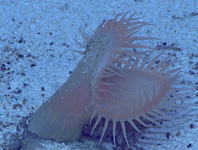Abstract
The adult male of a new species of the genus Polyplectropus Ulmer 1905a is described and illustrated based on specimens collected in Parque Nacional da Serra da Canastra, southeastern Brazil. Polyplectropus canastra sp. nov. can be distinguished from other Polyplectropus species by the shape of sternum IX, by the thumb-like mesolateral process of each preanal appendage, by the rectangular ventral branch of each inferior appendage in ventral view, and by the curved claw-like spines of the endothecal membrane. Among all species in the P. annulicornis Group, P. canastra is the only one with a bifid dorsolateral process of each preanal appendage and bearing spinules on the distal half of the rod-like lateral branch.
References
Chamorro, M.L. (2003) Seven new species of Polycentropodidae (Trichoptera) from Nicaragua and Costa Rica. Proceedings of the Entomological Society of Washington, 105 (2), 484--–498.
Chamorro, M.L. & Holzenthal, R.W. (2010) Taxonomy and phylogeny of New World Polyplectropus Ulmer, 1905 (Trichoptera: Psychomyioidea: Polycentropodidae) with the description of 39 new species. Zootaxa, 2582, 1–252.
Chamorro, M.L. & Holzenthal, R.W. (2011) Phylogeny of Polycentropodidae Ulmer, 1903 (Trichoptera: Annulipalpia: Psychomyioidea) inferred from larval, pupal and adult characters. Invertebrate Systematics, 25, 219–253.
http://dx.doi.org/10.1071/IS10024
Frost, S.W. (1957) The Pennsylvania Insect Light Trap. Journal of Economic Entomology, 50, 287–292.
http://dx.doi.org/10.1093/jee/50.3.287
Holzenthal, R.W. & Almeida, G.L. de (2003) New species of Polycentropodidae (Trichoptera) from southeastern and southern Brazil. Proceedings of the Entomological Society of Washington, 105 (1), 22–29.
Holzenthal, R.W., Blahnik, R.J., Prather, A.L. & Kjer, K.M. (2007) Order Trichoptera Kirby, 1813 (Insecta), caddisflies. Zootaxa, 1668, 639–698.
Holzenthal, R.W., Morse, J.C. & Kjer, K.M. (2011) Order Trichoptera Kirby, 1813. In: Zhang, Z-q. (Ed.), Animal biodiversity: An outline of higher-level classification and survey of taxonomic richness. Zootaxa, 3148, 210–211.
Johanson, K.A., Malm, T., Espeland, M. & Weingartner, E. (2012) Phylogeny of the Polycentropodidae (Insecta: Trichoptera) based on protein-coding genes reveal non-monophyletic genera. Molecular Phylogenetics and Evolution, 65, 126–135.
http://dx.doi.org/10.1016/j.ympev.2012.05.029
Malicky, H. (1992) Some unusual caddisflies (Trichoptera) from southeastern Asia (Studies on caddisflies of Thailand, No. 5). In: Tomaszewski, C. (Ed.), Proceedings of the 6th International Symposium on Trichoptera. Adam Mickiewicz University Press, Poznan, Poland, pp. 381–384.
Morse, J.C. (2015) Trichoptera World Checklist. Available from: http://entweb.clemson.edu/database/trichopt/index.htm (accessed 19 June 2015)
Santos, A.P.M., Dumas, L.L., Jardim, G.A., Silva, A.L.R. & Nessimian, J.L. (2013) Brazilian Caddisflies: Checklists and Bibliography. Available from: https://sites.google.com/site/braziliancaddisflies (accessed 9 June 2015)
Ulmer, G. (1903) Über die Metamorphose der Trichopteren. Abhandlungen aus dem Gebiete der Naturwissenschaften, Hamburg, 18, 1–154, pls. 1–4.
Ulmer, G. (1905a) Zur Kenntniss außereuropäischer Trichopteren. Stettiner Entomologische Zeitung, 66, 1–119.
Ulmer, G. (1905b) Neue und wenig bekannte aussereuropäische Trichopteren, hauptsächlich aus dem Wiener Museum. Annalen des Kaiserlich-königliches Naturhistorischen Hofmuseums, Wien, 20, 59–98.
Ulmer, G. (1951) Köcherfliegen (Trichopteren) von den Sunda-Inseln. Teil I. Archiv für Hydrobiologie, 19, 1–528.

